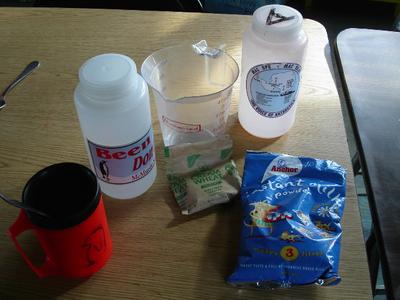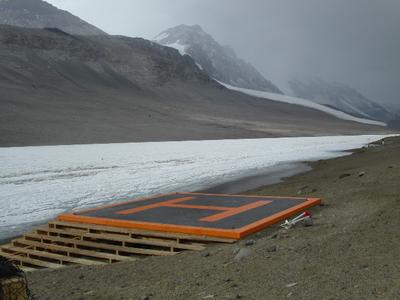
|
|
17 January, 2003
A Day At Lake Bonney Camp - Part 1
Today I thought perhaps it would be a good idea to try to explain camp life
here at Lake Bonney, focusing on our routines and the facilities.
7:30am. I woke up today to the sound of the canvas tent billowing from the
winds and the vibrations of the tie downs straining to hold the tent in
place. I pulled my sleeping bag up over my head as I could feel a draft on
my neck and shoulders. Hearing the wind whipping about the tent isn't the
most inviting sound, so I stayed tucked in my bag for a few minutes
mustering up the motivation to wiggle out of the fleece liner and face the
chill of the cold tent. After all, it took until 5:00am for my sleeping bag
to be warmed up enough for me to stop shivering, and now I have to crawl
out! One, two, three, go... I quickly jump into my long underwear bottoms,
a silk turtleneck, then a capaline turtleneck, a fleece coat, and heavy
black bib wind pants. I powder up my feet, reach up and grab a pair of wool
socks from the rope line hanging over my head. I have four pairs rotating
that I use. With mine and Amber's combined, it makes for quite an aromatic
tent. But foot care is critical. Your feet sweat in the bunny boots and it
is important to try to keep them dry and to use powder liberally. I slip my
feet into my boots and then reach behind at my heel to pull out the flap of
rubber that folds in every time I put them on. I won't bother to lace them
up until after breakfast.
Next I grab my bag of essentials for the day, extra socks, fleece balaclava,
wool mittens, heavy leather gloves, seal waterproof gloves (Different tasks
require different gloves), water bottle, P bottle, hand warmers, and my
cameras. I put on my hat and my red windbreaker jacket. When you are
working you don't need your heavy down coat. You get too hot and it is too
bulky to work in. There are also certain things you keep handy in your
large jacket pockets such as sun block, lip balm, tissues, liner gloves,
earplugs (for when we use the jiffy auger), emergency whistle, and a
leatherman. I release the black tab on our drawstring tent doorway... first
to the beige lightweight inside liner, then to the heavier yellow canvas
outside layer. I have come to dread entering and exiting the tent. You
nearly always get your hood caught at the top, or snag your foot on one of
the tent layers and find yourself stumbling to catch your balance. I
thought I would get better at this as time went on, but it seems the reverse
is true. You often see people stumble and mutter to themselves as they pass
through their tent doors.
Once free of the tent, we all descend on the cook tent. As soon as you
unzip the door, Chris greets you with a hello and asks how you slept. I
maneuver to an available wooden crate and bid good morning to other members
of the team who have also had the courage to leave their cozy sleeping bag.
I ask if someone will pass me my large measuring cup. We each have one that
we use as our bowls. The choice today is cold cereal with powdered milk or
hot cereal. I select an instant packet of apple and spice cream of wheat.
I prefer the flavored oatmeal, but we are now three weeks into the trip and
the flavored oatmeal is gone. We have all avoided taking the regular flavor
because it is a bit like eating wet, mashed cardboard. I pour a hot cider
packet into my insulated plastic red mug. It is distinguishable from
everyone else's because we have each drawn something on the outside with
permanent marker. On mine I wrote "M.A" in large letters and drew a
rockhopper penguin on it. Others have labeled theirs with a nickname or
symbol. Next, I carefully stand to move towards the primus stove for some
boiling water. Chris always sits on the same rock box near the stove and
holds the cover of the water pot while people ladle in the hot water for
their cereal and drinks. Then every ten minutes or so, he reaches down and
pumps the stove to keep the fuel level up.
After eating, I ask Chris for a paper towel. Again, he lifts the cover off
the pot, and like everyone, I dip one end of my towel into the hot water and
then wash off my plate and spoon. We run a dry camp, which means we do not
produce gray water. For example, if we cook pasta, we don't use as much
water as you would if you were cooking at home, and then we boil away
whatever water is left. If you produce gray water, you need a place to dump
it and we do not travel with gray water barrels at tent sites. Things are
different if we go down the hill to the jamesway, but we have decided to
remain eating some of our meals in the cook tent so as to minimize our
intrusion on the LTER group also using the jamesway.
At breakfast we get our assignments for the day. This morning I will help
pack up and tie a helicopter sling load (I'll cover sling loads in a
separate journal entry) for our next camp move and then head to the jamesway
to spend the remainder of the day sorting through my pages of e-mails. Soon,
I will not have access to the Internet again, and so Chris and Brenda have
been kind enough to provide this time for me while it is available.
The jamesway hut is warm and provides a shelter from the strong winds. It's
not pretty, but it's very cozy compared to the outside weather. Tom and I
have spent time in here late at night writing journals and doing work. Like
a quiet house that settles at night, the jamesway also has its share of
unique sounds. Sitting at my computer I face the pale green canvas shell
that is supported by an arched wooden frame painted military green. When
the winds pick up, the canvas puffs outward and then collapses in making the
hut seem like it is breathing. There is a valve inside the stovepipe of the
propane heater that squeaks and scrapes every time the wind blows. From
outside you can hear the constant whirling sound made by a windmill that
charges large batteries providing power to the jamesway. Once and a while
you hear a deep single bellow from one of the black barrels outside as it
contracts and expands. It sounds as if someone has just kicked in the side
of the barrel, but no one is out there. Another familiar sound is that of
helicopters moving through the valley. Some days are busier than others
depending on weather and scheduled activities. You can hear them coming
long before you see them, especially the larger Coast Guard helos with their
deep thug, thug, thug sound from the rotor blades. You can even feel the
sound vibrations in your chest as the helo approaches. Today the helo
traffic is heavy because they are moving several items around the camp using
sling loads. The pilots must take their time maneuvering equipment in
slings and so the helos have been hovering around the hut all morning. It's
extremely noisy and with the vibrations that have been jolting through my
body, I feel like I have been to a wild rock concert where the bass was
cranked to its maximum.

My red mug, my water bottle, pitcher for cereal, hot cereal, and powdered milk. We all put stickers on our water bottles to distinquish them from our P bottles which are exactly the same. Don't want to confuse those containers!

These large black barrels are used to store gray water, urine, and mogas (fuel). The barrels are kept inside of a giant rubber drip pan for containment of any spills.

A shot of the helo pad located at Lake Bonney. The F6 Camp and Fryxell Camp did not have a helo pad, but here there are not any flat places to land, so one had to be installed.

This is the noisy propane heater located in the jamesway. It may clang a lot, but with the heat it throws, no one complains.
Contact the TEA in the field at
.
If you cannot connect through your browser, copy the
TEA's e-mail address in the "To:" line of
your favorite e-mail package.
|
